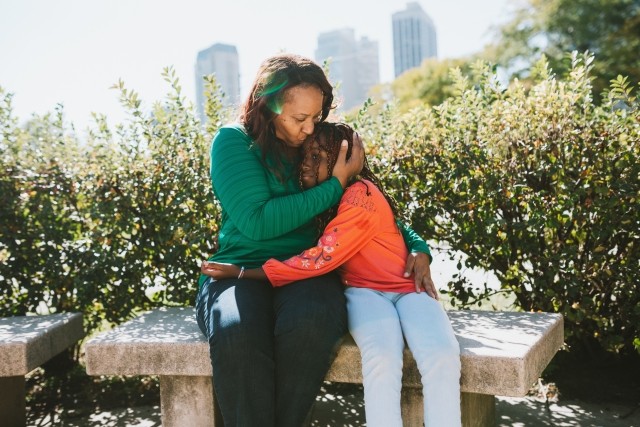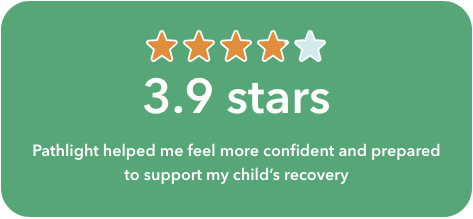A few years ago, your child wanted to tell you everything about their school day. Now, they come home and barely say a word. Is it just a part of growing up, or might it hint at a potential mental health issue?
“There’s no manual for how to approach every situation as a parent,” says Leslee Marcom, PhD, CEDS-C, regional clinical director at Pathlight Mood & Anxiety Center (Pathlight). “But fostering a supportive and open environment can help parents navigate difficult situations and start important conversations about mental health.”
Let’s explore some common child mental health problems, a few symptoms that parents may overlook and 11 practical ways to support your child or teen.

Which mental health conditions impact kids and teens the most?
Mental health in children and teens is a growing and concerning issue. In 2024, 20% of youth (ages 12-17) reported having at least one major depressive episode, up from 16% in 2023, according to statistics from Mental Health America. A major depressive episode is a period of at least two weeks in which a child experiences symptoms like low energy, feelings of hopelessness, poor concentration and/or changes in appetite.
Some of the most common mental health conditions affecting kids and teens today are:
- Depression
- Anxiety
- Post-traumatic stress disorder (PTSD)
- Obsessive-compulsive disorder (OCD)
- Attention-deficit/hyperactivity disorder (ADHD)
Often these conditions occur simultaneously. For example, 30% of children with ADHD will experience a mood disorder like depression, bipolar disorder or generalized anxiety.
Untangling mental health symptoms in kids and teens
Parents often struggle to identify the signs of mental health conditions in their kids. One reason is that symptoms can be masked by normal behavioral changes that children experience as they grow and develop.
“For example, during puberty, it’s common for children to experience more mood dysregulation, less open communication with their parents, negative self-talk and more disruption in their sleeping and eating behaviors,” Dr. Marcom says.
Despite parents’ best intentions, it’s also easy to overlook the signs of a child’s mental health issue, especially in children who don’t seem to exhibit typical symptoms. This is especially true, Dr. Marcom says, for behavioral issues in two types of children:
- High-achieving kids and teens. Children who get good grades, participate in school sports and strive for perfection may appear perfectly healthy. Sometimes, however, their high achievement levels are driven by underlying conditions like high-functioning anxiety or high-functioning depression, which can bring serious long-term risks to their overall mental state.
- Kids and teens with physical health complaints. Some children and adolescents feel more comfortable describing their physical symptoms to parents than their emotional ones. Stomach pains, headaches and joint pains can be physical representations of anxiety or depression.
How to support a child with mental health issues: Tips for parents
Parents can create a supportive home environment for their children by creating a safe space where all feelings — positive and negative — can be discussed. Here are four ways to do so.
1. Avoid ‘fix-it’ mode
It’s natural for parents to want to fix all their child’s problems. But doing so can bring unintended consequences.
“Kids and teens will likely stop coming to their parents if they’re in constant fix-it mode,” Dr. Marcom says.
A better approach, Dr. Marcom says, is to validate your child’s emotions so they feel as if you understand them.
2. Stay consistent and calm
Try to regulate your emotions while talking with your child about their mental health concerns. By maintaining a sense of calm, you’ll allow your child or teen to express themselves fully. In contrast, if you get angry, upset or sad during the conversation, your child may begin trying to take care of your feelings instead of discussing their own emotions.
3. Model by example
Parents can set a positive example for their children by integrating coping skills like deep breathing or relaxation exercises into their everyday lives and then encouraging their children to follow suit.
“Deep breathing helps reduce anxiety and stress by slowing your respiratory rate and increasing the amount of oxygen in your body, creating feelings of calmness,” Dr. Marcom says.
The key is to breathe in through your nose and out through your mouth. You can accomplish this by envisioning blowing bubbles, or through the following techniques:
- Box breathing: A four-step process where you inhale for four seconds, hold your breath for four seconds, exhale for four seconds, then hold your breath for four seconds while envisioning a four-sided object
- Triangle or ‘pizza’ breathing: A three-step approach where you inhale deeply, hold your breath briefly, then exhale while envisioning a three-sided object
4. Find balance with social activities
Involvement in hobbies and extracurricular activities can help kids and teens manage their stress and improve their mood. Examples to encourage include creative pursuits like art or journaling, athletic endeavors like dance or team sports, or volunteer opportunities in your community.
On the flip side, it’s also important to watch for the signs that your child might be overbooked. This can affect sleep, appetite, school performance and relationships.
How to start the conversation about child mental health
It’s natural for parents to feel anxious about discussing “feeling bad” with their children, so they may delay starting the conversation. The best way to overcome this barrier is to not overthink it.

“Start by telling your child that you’re supportive, understanding and open to hearing how they're feeling,” Dr. Marcom says.
Here are four ways to engage in a positive discussion.
1. Prepare in advance
If you’re nervous about having the conversation, try practicing it with your partner. Doing so will help you prepare for possible reactions from your child and give you more confidence when the time comes to have the actual discussion.
2. Be open and direct
Begin by discussing what you’ve observed and then ask open-ended questions that will encourage your child or teen to respond openly. One example:
“I’ve noticed you’ve been hanging out in your room more, and you seem sad lately. I was wondering if something was going on and if you wanted to talk about it. It is normal to have emotions that feel out of control at times, and I am here to support you.”
3. Expect pushback
Don’t be surprised if your child or teen doesn’t open up immediately. Resistance is typical, Dr. Marcom says. If you practice the discussion in advance, prepare for resistance so you can manage your own emotions better during the actual conversation.
4. End on a positive note
Always finish the discussion by reaffirming that you care about your child and want what’s best for them.
How to help a child or teen in crisis and find professional support
80% of parents felt their child’s Pathlight care team met their expectations
If you are concerned about any of your child’s behaviors, seeking help from a therapist or other mental health professional is the best next step.
“If you’re not sure where to find help, ask people you trust at your child’s school,” Dr. Marcom says. “School officials are often very connected within their community and can refer you to a professional.”
Here are three ways to help set up your child for success with therapy.
1. Normalize therapy
Kids and teens may resist therapy at first because they think it means that something is “wrong” with them. Parents can help combat this misconception by explaining that stress is a normal part of life, and that seeking help is a brave step.
“Tell your child that there are times in everyone’s life when they need some additional support, and now might be one of those times,” Dr. Marcom says.
2. Share your personal experience
If you’ve had a positive, personal experience with therapy in the past, share it with your child or teen. Doing so will help reinforce that people of all ages seek help at different stages of their lives. Also, if you as a parent are struggling with any mental health issues, attend therapy, too, so you can role-model positive behaviors for your child.
3. Encourage vulnerability
Let your child know that it’s typical to feel uncomfortable with therapy at first. Sharing personal feelings with a professional who starts out as a stranger can be challenging. Reassure your child that therapy becomes easier as they become more comfortable with their therapist and build trust.
Explore child and teen mental health treatment at Pathlight
89% of parents say they’re likely to recommend Pathlight
It can be difficult to watch your child or teen struggle with a mental health issue, but help is available. Pathlight is one of the nation’s leading centers for mood and anxiety disorders, with a proven record of helping families achieve life-changing recovery.
Children and adolescents show a significant decrease in anxiety and depression symptoms while in our care.
See how our personalized, comprehensive approach to mental health has helped other children, teens and their parents. If you feel Pathlight might be the right choice for your child, call us at 866-622-5914 or schedule a quick 15-minute call today. We’ll listen to you and help you find the right level of support.


